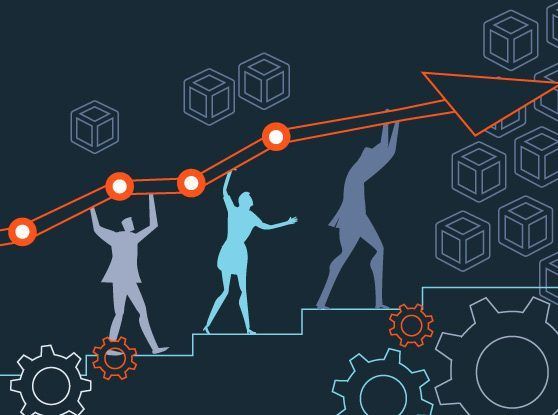Myth-busting 3 common product-led growth misconceptions that can hold you back

In talking to many Insight Partners portfolio companies about product-led growth (PLG), it is clear that there are a lot of misconceptions about the topic that lead some companies to shy away from PLG opportunities, or to think “this is not for us.”
Here, we will be focusing on clarifying some of these myths to help you through your PLG decision-making process.
Myth 1: Product-led growth is “giving product the keys” to strategy
One common misconception about PLG is that your PLG strategy starts and ends in the product organization. It doesn’t.
One common misconception about PLG is that your PLG strategy starts and ends in the product organization.
Product-led growth is a growth strategy driven by customer interaction with your product, and not a product strategy in itself. For PLG to be successful, it requires full alignment at all levels of your company, and across all GTM teams:
- Product plays a key role in improving and optimizing the user experience so that your company can effectively execute on your PLG vision. By optimizing your product, you can significantly reduce customer pain points and friction, so you can convert and expand customers more effectively.
- Marketing is typically in charge of making the top-of-the-funnel acquisition a success, gaining signups, and then tracking their performance through the conversion funnel to continually optimize advertising strategy and spend. Without marketing, PLG models wouldn’t have users that could be converted into customers. Marketing further engages with the community of free and paying users who become a significant source of product awareness, and strong advocates for your company.
- Sales is instrumental in most PLG models (as demonstrated in the next two sections) because a sales team can offer advantages in value selling, revenue extraction, and customer relationship management that PLG alone cannot.
- Customer success is key to ensure that customers are supported and will grow their usage of the product in a cost-effective way. Typically, in low-touch PLG environments (like freemium, free trial, and self-service), the successful organization needs to scale to support thousands of lower-revenue customers.
- Finance input is typically needed to ensure that the complex self-service billing and provisioning systems in most product-led companies are managed correctly. The finance team will also take an instrumental role in tracking the margin of the PLG model as a whole (e.g., “free” offerings such as freemium and free trials will incur cost while providing no revenue until conversion).
- Revenue strategy/pricing is very important to the success of a PLG motion, both in optimizing the price point of the initial conversion to keep customers in the funnel, and the pricing strategy to ensure that customers can continually expand their spending. If your pricing model is too complex, doesn’t scale with deployment size (this is where usage-based pricing shines brightest), or isn’t aligned with customer value, then your PLG strategy is unlikely to succeed.
Myth 2: Product-led growth is unsuitable for enterprise
Another common misconception about product-led growth is that it’s only suitable when selling small-ticket deals to consumers and SMBs.
The truth is that companies such as Atlassian, Twilio, Snowflake, AWS, and others wouldn’t be the successes they are without enterprise sales. These companies have perfected a motion where their product, pricing, and sales model work in tandem to convert leads to seven-figure deals through smart usage of product-led growth principles. There are a few important things to bear in mind when implementing PLG within an enterprise motion.
The role of freemium, free trials, and open-source changes significantly
Instead of being a direct link to real contracts, treat interest within these channels as a lead-generation engine to provide warm product-qualified leads who are familiar with your product. These can then be farmed by your sales team when they have reached a point of seeing value and wanting to expand. Ensure that you capture key demographic info such as a business email address, and then enrich this data with further information about the company (such as the number of employees, industry, ICP fit, etc.) to generate a list of potential sales targets.
Customer growth becomes key
All of the PLG companies above utilize a land-and-expand strategy. They start by winning initial contracts within a team or business unit of the enterprise company and then expand into further teams and business units as more people become interested in the product. This is often advantageous to the enterprise sale because you’ve already proven your ROI with the smaller deals by the time your company comes to sell the big-ticket global deal to that customer. Your track record supports the high contract value.
Customer success plays a vital role
Because the focus is shifted to land-and-expand, the key to winning large enterprise deals is not having a flashy sales pitch. It’s having real proven success from smaller deals. Your success team will be vital in ensuring that this happens, and then they (or expansion-focused salespeople) will have the task of suggesting other areas where the customer could use your product to ensure that that customer expands.
Myth 3: Product-led growth will replace your sales team
In several product-led companies we have worked with, there is a concern among sales teams that the PLG motions (particularly self-service sales) are there to “automate their job” and take deals that could have been theirs. However, in the majority of cases, the exact opposite is true.
Product-led growth often becomes the main lead generation engine for a company, delivering more leads – and more importantly, more high-quality leads – to the sales team than the deals that it cannibalizes. Our portfolio companies have increasingly been describing this motion as a “sales acceleration tool.” We would recommend stepping away from the mindset of “PLG vs. Sales” and instead understand how you can interlink PLG and sales motions to deliver the best results.
- When it comes to selling high-value deals at revenue-maximizing prices, a well-trained sales team still wins out over PLG. As such, most of the best PLG companies operate a hybrid model where small business and some team-level deals with larger companies are handled by the self-service motion, and any larger contracts (e.g., 5-figure deals and above) are handled by sales teams. Even Atlassian, a staunch champion of the “we don’t need a sales team” PLG movement of the 2010s has since adopted a sales motion at the enterprise level.
- In our experience, one of the biggest constraints when scaling a company is the pace at which you can hire and ramp salespeople. By using their time most effectively, you not only get the best bang-for-your-buck, but you also unlock faster growth. Your salespeople will still have plenty to do even after refactoring their role towards selling higher-value deals.
Here is a practical split of roles and responsibilities under a hybrid PLG model. Without PLG, these would all need to be driven by marketing and/or sales (including customer success and sales engineering).

PLG misconceptions can hold you back
PLG is a wide-ranging business strategy and has emerged as a new growth motion in software go-to-market strategy. Misconceptions about PLG can hold companies back from adopting PLG and realizing the benefits. We hope these clarifications provide a new perspective, and we would encourage you to consider how you could leverage elements of the PLG toolkit to improve your go-to-market motion.
If you have any questions or would like our thoughts on any aspect of PLG, please email us at PLG@insightpartners.com.
Quiz: Is Product Led Growth Right For Your Business?
Take this interactive quiz to find out if you should leverage a Product-Led Growth or Sales-Led Growth go-to-market strategy.
ASSESS







